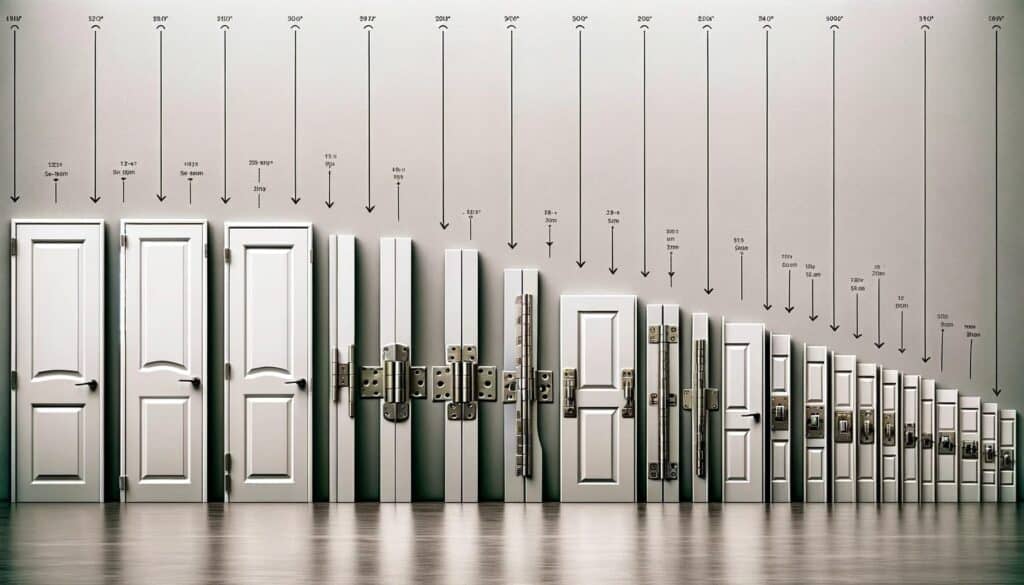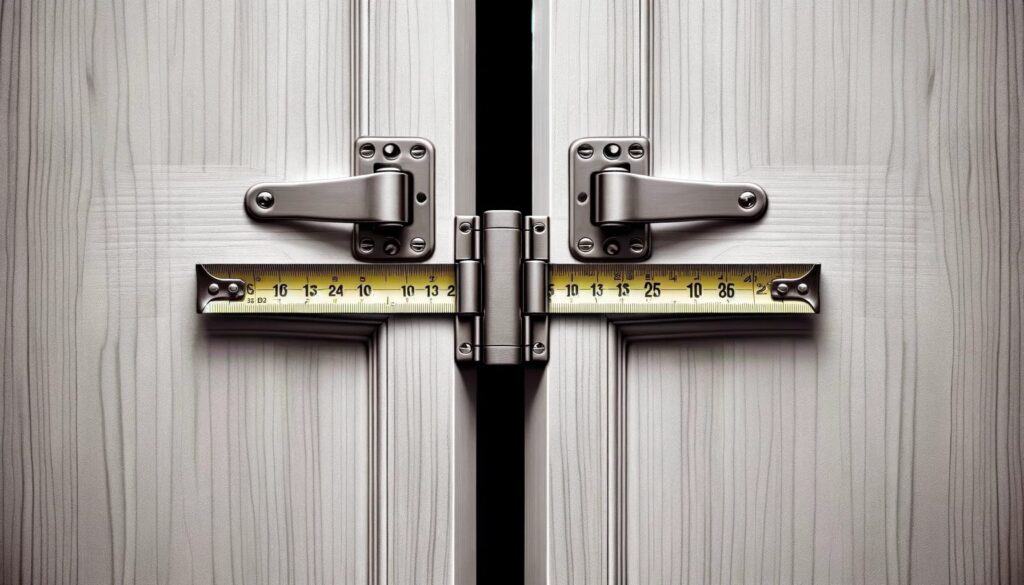
Did you know that door hinges can be spaced differently depending on various factors?
It’s not as simple as assuming that all door hinges have the same spacing. The placement of hinges on a door can greatly affect its functionality and durability.
So, if you’re interested in learning more about how door hinges are spaced and the reasons behind it, keep reading. You might be surprised by what you discover!
Key Takeaways
Properly spacing door hinges is crucial for ensuring smooth operation, stability, and long-lasting durability of the door. To provide adequate support, align the bottom hinge with the bottom of the door and position the top hinge around 5 inches from the top. If a third hinge is necessary, place it between the top and bottom hinges.
Accurate hinge placement is essential for the proper installation of a door.
Door Hinges Standard Size
The size of door hinges is determined by the weight and size of the door. Generally, lighter hollow core doors require two hinges, while heavier solid core doors often need three or four hinges for proper support and stability.
Hinge spacing should match existing doors in the structure and is traditionally set at 7 inches from the top and 11 inches from the bottom. This ensures proper alignment and functionality of the hinges.
It’s important to note that hinge placement can be influenced by historical and regional factors, as well as personal preference and aesthetics.
Careful consideration of the size and spacing of door hinges is essential for the stability and longevity of the door.
Factors Affecting Hinge Measurement
When it comes to measuring hinges, it’s important to understand that the dimensions can vary depending on the specific requirements of the door. Factors like the door’s weight also play a crucial role in determining the spacing of the hinges.
It’s worth noting that there are different types of hinges, each with its own unique characteristics that can affect the measurement process.
Hinge Dimensions Vary
Hinge dimensions can vary due to various factors that affect their measurement. Regarding door hinges, several key factors can influence their dimensions.
These factors include the type of material used, the design of the hinge, the weight capacity it can handle, and the size of the door itself. For example, a steel hinge may have different dimensions than a brass hinge. Hinges with more knuckles may be larger in size. Additionally, hinges designed to support heavier doors may have larger dimensions.
Considering these factors when selecting door hinges is important to ensure the dimensions are compatible with your needs.
Door Weight Affects Spacing

To ensure that a door is properly supported and functions well, the number and placement of hinges are determined by its weight. Heavy doors require more hinges for added stability, while lighter, hollow-core doors may only need two hinges. On the other hand, solid core or exterior doors may require three or four hinges.
The door’s weight affects how the hinges are distributed and spaced to ensure proper support. The top hinge is usually positioned closer to the top of the door to prevent rubbing on the frame, while the bottom hinge is typically placed about 10 inches from the bottom for stability.
It’s important to have equal spacing between the hinges to keep the door straight and aligned, considering factors such as the door’s size, weight, and width. Proper placement of hinges is crucial for the door’s stability, longevity, and smooth operation.
Different Hinge Types Exist
Different types of hinges exist, each with its own factors that affect hinge measurement. It’s important to consider the specific hinge type.
Here are some of the different hinge types and the factors that influence their measurement:
- Butt Hinges: These are the most common type of hinges used for doors. Factors such as door weight and size determine the number of butt hinges needed. The hinge’s size and placement also affect the door’s overall stability and function.
- Pivot Hinges: These hinges allow the door to pivot on a single point. The placement and size of pivot hinges are crucial for proper door swing and balance.
- Continuous Hinges: Also known as piano hinges, these long, continuous hinges are often used for heavy doors or doors that need extra support. The length and thickness of the continuous hinge determine its overall strength and durability.
- European Hinges: These hinges are commonly used for cabinet doors and offer a clean, streamlined look. The size and placement of European hinges impact the opening and closing mechanisms of cabinet doors.
The specific type of hinge used is essential when measuring and installing door hinges to ensure proper functionality and longevity.
Width Considerations
When considering the width of a door, it is important to consider its impact on load-bearing support and the need for specialized hinges to ensure stability. The width of a door directly affects its weight-bearing capacity and overall stability. Wider doors require stronger hinges that can handle the increased load. Additionally, the width of the hinges can impact the door’s weight and swing radius. It is crucial to position the hinges on the higher side of the door to prevent sagging. Specific guidelines should be followed for hinge spacing, such as placing the bottom hinge 10 inches from the bottom and the top hinge 5 inches from the top. The table below summarises the recommended hinge spacing for different types of doors.
| Door Type | Number of Hinges | Recommended Spacing |
|---|---|---|
| Light, hollow-core doors | 2 | 10 inches from bottom, 5 inches from top |
| Solid core or exterior doors | 3 or more | 10 inches from the bottom, 5 inches from the top, evenly spaced between |
Considering the width of a door is crucial for determining the appropriate load-bearing support and specialized hinges needed for stability. By following recommended spacing guidelines, the longevity and proper operation of the door can be ensured.
Knuckle Length Variations
Understanding the variations in knuckle length is important for choosing door hinges that align with each door’s specific requirements and characteristics. This ensures proper installation and optimal functionality. Here are four key points to consider:
- Knuckle length refers to the different lengths of the individual parts of the knuckle on a door hinge, typically measuring 0.25 inches or 0.5 inches. It can impact the overall appearance and functionality of the hinge.
- The knuckle’s length affects how the leaves come together, influencing the door’s smooth operation. Choosing the right knuckle length is crucial for achieving a seamless and efficient door movement.
- Proper measurement and consideration of knuckle length variations are necessary for door hinges’ appropriate installation and function. Neglecting these variations may result in misalignment and compromised functionality.
- By understanding knuckle length variations, you can select door hinges that are spaced correctly, ensuring that the door operates as intended. This attention to detail is important for maintaining consistency and reliability in door hinge installations.
Importance of Pitch in Hinge Spacing
The spacing of door hinges relies heavily on pitch. Pitch determines the proper alignment of the hinges, ensuring they’re correctly positioned to support the door’s weight.
It also impacts the door’s swing, contributing to smooth and efficient operation.
Maintaining the overall functionality and longevity of the door requires proper pitch in hinge spacing.
Pitch and Alignment
Proper door hinge alignment and spacing are essential for maintaining the stability and longevity of the door. Hinge spacing, one crucial factor to consider is the pitch.
The pitch refers to the angle at which the hinge is installed on the door and frame. Here are some key points to understand about pitch and its significance in hinge spacing:
- The pitch of the hinge determines the clearance between the door and the frame when the door is closed. A proper pitch ensures that the door closes smoothly without rubbing against the frame.
- Incorrect pitch can result in misalignment, causing the door to bind or stick. Adjust the pitch based on the weight and size of the door to ensure optimal performance.
Door Swing Considerations
Proper door swing considerations are crucial for determining the optimal pitch and spacing of the door hinges. This ensures smooth functionality and long-lasting durability.
While door hinges are typically evenly spaced for straightness and smooth operation, their placement isn’t arbitrary. It takes into account specific factors related to the door swing.
The top hinge is positioned closer to the top to prevent rubbing on the frame, while the bottom hinge is placed about 10 inches from the bottom for stability. These precise measurements ensure that the door opens and closes without any issues.
Correct hinge placement is essential for smooth door operation and alignment with the frame, ultimately contributing to its longevity.
Therefore, door swing considerations play a significant role in determining the appropriate spacing of door hinges.
Impact on Door Function

Considering the specific factors related to the door’s swing, the proper placement of door hinges ensures smooth operation and long-lasting durability. The spacing of door hinges is crucial for the overall performance of the door.
Here are four ways in which hinge spacing affects the function of the door:
- Alignment: When door hinges are evenly spaced, they help keep the door straight and aligned, preventing it from sagging or sticking.
- Stability: Correct hinge placement, such as positioning the top hinge closer to the top, promotes stability and prevents the door from rubbing against the frame.
- Weight distribution: The size and weight of the door determine the number of hinges needed and their spacing. Lighter doors typically require two hinges, while heavier solid-core doors may need three or four for proper support.
- Longevity: By ensuring that the hinges are properly spaced, the door’s weight is evenly distributed, reducing stress on the hinges and increasing their lifespan.
How to Measure Door Hinge Size
To accurately determine the size of a door hinge, I carefully measure its dimensions using a precise measuring tool.
The size of a door hinge is typically indicated by the length and width of its leaves.
To measure the length, I place the measuring tool at one end of the hinge leaf and extend it to the other end, taking care to measure from the outer edge of each leaf.
Next, I measure the width by placing the measuring tool at the widest point of the leaf and extending it to the opposite side.
It’s important to note that door hinges come in various sizes, ranging from 3 inches to 6 inches in length.
Proper Hinge Placement for Installation
After accurately measuring the door hinge dimensions, the next step in the installation process is determining the proper hinge placement. Proper hinge placement ensures the door functions correctly and aligns properly with the door frame.
Here are four key considerations for determining the proper hinge placement during installation:
- Alignment: The hinges should be aligned vertically and horizontally to ensure the door swings smoothly and closes securely.
- Spacing: The spacing between hinges should be uniform to distribute the door’s weight evenly and prevent sagging or misalignment.
- Door Size: The size and weight of the door will determine the number of hinges needed and their placement to provide adequate support.
- Frame Alignment: Proper alignment of the hinges with the door frame is essential for smooth operation and preventing binding or sticking.
Additional Resources for Door Hinge Installation
For more information on installing door hinges, it’s recommended to refer to the guidelines provided by the manufacturer and watch instructional videos that provide step-by-step instructions.
These resources can offer valuable information on correct spacing and installation of door hinges. The manufacturer guidelines often include specific measurements for hinge placement based on the size and weight of the door. They may also suggest the number of hinges needed for optimal support.
Instructional videos can provide visual demonstrations of the installation process, making it easier to understand and follow.
Additionally, online forums and DIY websites can be helpful sources of information, as they often offer tips and advice from experienced individuals who’ve installed door hinges themselves.
Utilizing these resources will ensure a successful and accurate installation of door hinges.

Frequently Asked Questions
Are All Door Hinges Spaced the Same?
Door hinges can vary in spacing. It’s important to consider hinge compatibility, variable spacing, and installation tips. Factors such as door weight, construction, and personal preference can influence how the hinges are spaced.
Do Door Hinges Need to Be Evenly Spaced?
Yes, door hinges should be evenly spaced for proper door alignment. Uneven spacing can cause the door to sag, rub against the frame, and become unstable. To ensure even hinge spacing, accurately measure and mark the desired distance before installing the hinges.
Are Door Hinge Locations Standard?
Door hinge locations are generally standardized. Common types of hinges for doors include butt hinges and continuous hinges. The spacing of door hinges can be influenced by factors such as the door’s type, size, and weight. It is important to install door hinges properly to ensure stability and functionality.
What Spacing Should Hinges Be Set at on Doors?
Yes, it is important to align door hinges for optimal functionality properly. Incorrect hinge spacing can result in misalignment, so it is crucial to follow specific guidelines based on the size and weight of the door to measure and mark hinge locations accurately.
Do Left and Right Door Hinges have the Same Spacing?
When it comes to door hinge orientation clarification, it’s important to note that left and right door hinges do not have the same spacing. The hinges are specifically designed and placed to accommodate the swing of the door, so it’s crucial to pay attention to the correct orientation when installing or adjusting them.
Do Kitchen Hinges Use the Same Spacing as Regular Door Hinges?
Yes, all kitchen hinges use the same spacing as regular door hinges. This means that you can easily replace or upgrade your kitchen hinges with standard door hinges, should the need arise. This makes maintenance and repairs simpler and more convenient for homeowners.
Final Insights: The Standardization of Door Hinge Spacing
The proper spacing of door hinges is essential for the door’s smooth operation, stability, and longevity. Aligning the bottom hinge with the bottom of the door and placing the top hinge around 5 inches from the top provides adequate support. If a third hinge is needed, it should be positioned between the top and bottom hinges.
Correct hinge placement is crucial for a well-installed door.

Hi, I’m George Anderson, an expert installer with an extensive door installation and maintenance background. I’m passionate about sharing my knowledge on door equipment and accessories through my writing, helping homeowners make informed decisions. My specialty lies in custom door installations, with a commitment to enhancing the aesthetics of every home. Please feel free to reach out anytime for help with door-related questions or needs.










